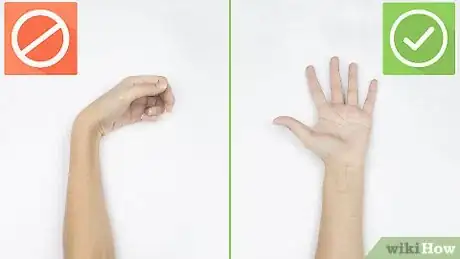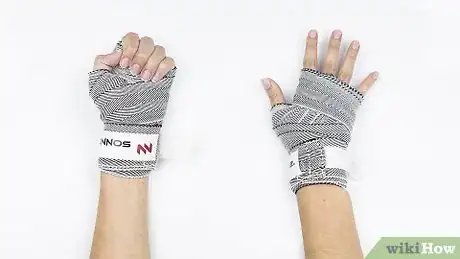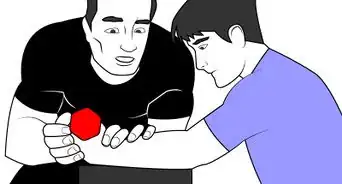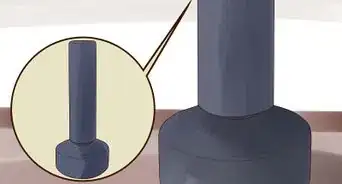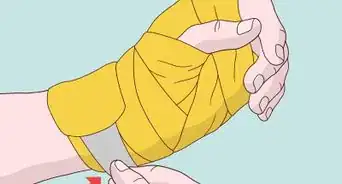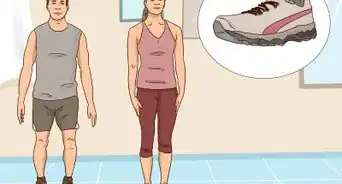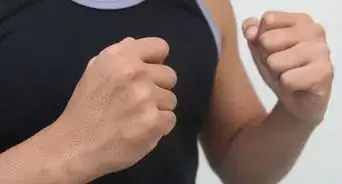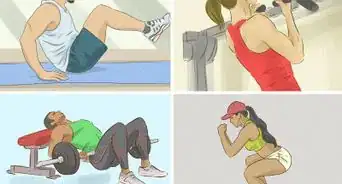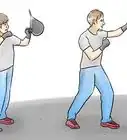This article was co-authored by David Engel. David Engel is a Muay Thai Instructor and Self Defense Trainer based in the San Francisco Bay Area. With over 15 years of martial arts instruction and training experience, David runs California Martial Athletics with co-owner Joe Chernay. He has created and maintained martial arts programs at Rise Combat Sports in San Francisco and Round 5 Martial Arts Academy in San Leandro, with a mission to provide students with a level of comfort and competency that manifests both within and outside the martial arts context. He is also a registered cornerman for amateur and pro competitors under the IKF (International Kickboxing Federation). David was the youngest apprentice instructor of the Thai Boxing Association of America under Ajarn Chai Sirisute (2009), and was a top-ranked amateur competitor in his weight class (127-130 lb) in California between 2013 and 2015.
There are 8 references cited in this article, which can be found at the bottom of the page.
This article has been viewed 1,257,558 times.
Before putting on boxing gloves and entering the ring, boxers wrap their hands in a thin band that protects the tendons and muscles and lends additional support to the movements of the wrist. Boxing wraps come with a strip of Velcro at one end so that the wrap can adhere to itself. Read on for instructions on how to wrap your hands for a training session.
Steps
Using the Right Wrap and Technique
-
1Choose the right wrap. There are many different types of wraps, and it's important to choose one the one that will work best for the size of your hands and the type of boxing you intend to do. Consider these options when you're picking out a wrap to buy:[1]
- Cotton wraps are a good choice for frequent training. They come in adult and junior lengths, and they are secured with velcro at the end.
- Mexican wraps are similar to cotton wraps but they are woven with elastic fibers, so they mold to the hand more easily. They aren't quite as durable as cotton wraps because the elastic gets worn out over time, but they're a good option for training.
- Gel wraps aren't actually woven onto the hand, but are slipped on like fingerless gloves. They are more expensive than cotton or Mexican wraps. They are convenient to slip on, but they don't provide as much wrist support as traditional wraps, and for that reason serious boxers don't usually opt for gels.
- Competition wraps are composed of gauze and tape. Boxing rulebooks specify the exact amount that can be used, to make sure each boxer has the same amount of padding. Since these wraps aren't reusable, they aren't practical for use during everyday training. The wrapping technique for competition wraps is also different and should be done with a partner or coach.
-
2Wrap with the correct tension. Hand wraps should be taut to provide stability for the hand and wrist, but if they're too tight they can cut off circulation. You might have to practice a few times before you get the tension just right.Advertisement
-
3Keep the wraps free of wrinkles. Lumps and wrinkles can be uncomfortable when you're trying to focus on boxing, and they also prevent the wrap from adequately protecting the fine bones in your hands and stabilizing your wrists.
-
4Keep your wrists straight when you wrap them. If your wrists are bent when you wrap them, they the wrap won't help to stabilize them. Your risk of injury won't be as high if you keep your wrists straight during the process.
Winding the Wrap
-
1
-
2Place your thumb through the hole at the end of the wrap.[3] It's located at the opposite end from the Velcro. Make sure the underside of the wrap is against your hand; if you wind the wrap upside down, you'll have trouble fastening it when you're finished. Most wraps will have a tag or printed place letting you know which side should face down.
-
3Wrap your wrist. Wind the wrap around the back of your wrist 3 to 4 times, depending on the size of your hands and the level of stability you want to attain. Finish with the wrap at the inside of your wrist.[4]
- The wrap should be flat and directly overlap itself with each turn.
- If you find that you need to add or reduce length to the wrap at the end, adjust the number of times you wrap your wrist.
-
4Wrap your hand. Pull the wrap around the back of your hand, over the area just above your thumb, and across your palm to the other side.[5] Wrap the same place three times, ending with the wrap on the inside of your hand near the thumb.
-
5Wrap your thumb. Start by wrapping your wrist one time, finishing with the wrap near your thumb. Wind the wrap from the bottom of your thumb toward the top, then back to the bottom. Finish by wrapping your wrist once more.
-
6Wrap your fingers. Starting at the inside of your wrist, wind the wrap in the following way to secure your fingers at the base:[6]
- Wind the wrap from the inside of your wrist over the top of the hand and between the pinky and ring finger.[7]
- Wind it back from the inside of the wrist over the top of the hand and between the ring finger and middle finger.
- Wind it again from the inside of the wrist over the top of the hand and between the middle finger and index finger. Finish at the inside of the wrist.
-
7Wrap your hand again. Start by wrapping the wrist, then wrap diagonally from the inside of your wrist to the outside of your hand. Continue wrapping across your palm and just above your thumb. Repeat until the length of the wrap has been used, then finish with one last wrap around your wrist.
-
8Secure the wrap. Velcro it to secure it in place. Flex your hand and throw a few punches to determine if it's comfortable. If the wrap is too tight or too loose, redo it.
-
9Repeat with the other hand. It may be difficult to wrap using your non-dominant hand at first, but you'll get the hang of it after some practice. If you need help ask your coach or a partner to do it for you.
Community Q&A
-
QuestionCan a novice use hand wraps?
 Joe SweeneyCommunity AnswerNot only can a novice use hand wraps, they should. All professional fighters, not just boxers, use hand wraps. You could do without them, but you'd risk breaking your wrists and being unable to fight.
Joe SweeneyCommunity AnswerNot only can a novice use hand wraps, they should. All professional fighters, not just boxers, use hand wraps. You could do without them, but you'd risk breaking your wrists and being unable to fight. -
QuestionCan I use athletic tape as a wrap?
 Community AnswerYes, but you obviously could not reuse the athletic tape and it would probably require a lot more tape each time you wrap your hand/wrist. It might also be uncomfortable between your fingers.
Community AnswerYes, but you obviously could not reuse the athletic tape and it would probably require a lot more tape each time you wrap your hand/wrist. It might also be uncomfortable between your fingers. -
QuestionDoes wrapping make the punch more effective when striking an opponent?
 Community AnswerNo, it doesn't. The wraps are there for the protection of your wrist and hand. They help ensure that there's no injuries when you do decide to give that hard punch.
Community AnswerNo, it doesn't. The wraps are there for the protection of your wrist and hand. They help ensure that there's no injuries when you do decide to give that hard punch.
Warnings
- Do not wrap too tightly. Wrapping hands is meant to support the hand and wrist, not to cut off circulation. If the wraps do not feel comfortable inside the boxing gloves, or if your hands feel numb, take off the wrap and wrap your hands more loosely.⧼thumbs_response⧽
Things You'll Need
- Boxing wrap
References
- ↑ https://www.artofmanliness.com/articles/boxing-basics-part-i-how-to-wrap-your-hands/
- ↑ https://greatist.com/fitness/how-to-wrap-hands-for-boxing
- ↑ https://www.expertboxing.com/boxing-basics/how-to-box/how-to-wrap-your-hands
- ↑ https://greatist.com/fitness/how-to-wrap-hands-for-boxing
- ↑ https://supremeteamboxing.com/how-to-wrap-your-hands-for-boxing/
- ↑ https://www.titleboxing.com/news/how-to-wrap-your-hands-in-10-easy-steps/
- ↑ David Engel. Muay Thai Instructor & Self Defense Trainer. Expert Interview. 5 May 2020.
- Videos provided by pound4poundflorida
- http://artofmanliness.com/2010/06/17/boxing-basics-part-i-how-to-wrap-your-hands/
About This Article
To wrap your hands for boxing, stretch your hand out with your fingers spread, and place your thumb through the loop at the end of the wrap. Then, wrap your wrist 3-4 times so that it’s snug and supportive, but not tight. Wrap your palm 3 times just above your thumb, and then wrap your wrist another time. Circle around your thumb 2 times and then wrap the wrist again. Starting at your wrist, wrap between your pinky, ring, middle, and index fingers before wrapping your hand again. At the end of the roll, wrap your wrist again and velcro the wrap into place. If you want to learn how to choose between wraps to use, keep reading the article!

